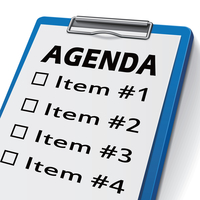Agenda in Robert’s Rules

© Can Stock Photo/kchungtw
Taking the time to construct a powerful agenda will make a big difference to your meetings. Avoid these agenda mistakes:
- An agenda that would take two days to get through, not two hours.
- An agenda that fails to assign suggested time limits for discussion.
- An agenda that is emailed at 6:00 am for a 7:00 am meeting.
- An agenda that is not sent out in advance at all, but is distributed at the start of the meeting.
- An agenda that fails to assign a number to each item.
- Including “old business” on your agenda instead of “unfinished business.”
What is an agenda?
An AGENDA is a list of items of business to be taken up at a particular meeting. It is prepared by the leadership in advance of the meeting—usually the president and secretary or clerk get together to make up the agenda. The agenda is a suggestion to the group. The group itself has final authority over the agenda.
Some people say that you should take as long to prepare your agenda as the meeting will take. There’s no doubt that considering your business items carefully, and weighing how much discussion each will need, is an important step towards creating a successful meeting. This is hard work! You are boiling down all the activities of your organization into a time slot that is almost always shorter than you need.
An agenda and its supporting materials should be sent out to the group at least a week in advance. This can be a challenge for volunteers! However, it is necessary if the members of the body are to exercise their duty of care and give the matters coming before the board due diligence.
Do you have to adopt an agenda?
If your group follows the standard Order of Business (see below), there is no need to adopt an agenda at the beginning of the meeting. However, many groups do adopt the agenda. It takes a majority vote (more than half) to adopt an agenda, and the question can be debated. Once an agenda is adopted, it takes a two-thirds vote to change it later in the meeting.
Public bodies may change the agenda by removing or postponing items, but must observe notice requirements in deciding whether to add anything.
What is the Order of Business?
The ORDER OF BUSINESS is the framework that your organization uses to construct its agendas. It sets out classes or categories of business, without listing individual items. Robert’s Rules of Order gives this Order of Business:
- Approval of Minutes
- Reports of Officers, Boards, and Standing Committees
- Reports of Special Committees
- Special Orders
- Unfinished Business and General Orders
- New Business
Jurassic Parliament believes that this order of business does not work well for many organizations. By scheduling NEW BUSINESS at the end of the meeting, you run the risk that the meeting participants will be exhausted at that time, just when creative energy is needed.
We recommend that nonprofit boards adopt a special rule of order that will allow the president to vary the order of business. Frontloading the agenda with key items will allow everyone to bring their best thinking to those issues. Reports, unless they require action, can come at the end of the meeting. See our article What are special rules of order in Robert’s Rules on how to do this.
Consent agenda
See our article on the consent agenda for information about this time-saving device.
Time indicators in an agenda
We recommend that agendas include a notation for the time allotted to each item. It’s also important to note that “all times are approximate” or to put “estimated” after the times. This means that if a discussion is running over, the chair can say, “Is there any objection if we give five more minutes to this item?” without having to take a formal vote to extend the debate.
Extra items in an agenda
It’s a good idea to put your mission statement at the top of the agenda, to help everyone keep focused.
It’s helpful to label items “Information, Discussion, Decision,” so people can anticipate what is coming up.
It’s helpful to list who will lead the discussion on each item. It may make sense for a committee chair to answer questions on a report, for example. Note that the chair should retain overall control, and should be the one who conducts actual discussion and voting.
It is fine to include draft motions in an agenda, as long as everyone understands that these are merely suggestions. They will not have standing until someone moves them at the meeting.
We include “Let’s connect” as an agenda item for board members to share a little tidbit of professional or personal information that will be of interest to their colleagues. Research has shown that trust grows when people have more information about each other. This must be brief—not a report on everything that’s happened in your life since the last meeting! Just a few interesting words will be appreciated. People can pass if they wish.
We include “Review of action items” because it is sometimes hard to keep everybody on the same page, remembering the tasks that they have agreed to do. See also our article, Action Items List will improve board followup, for more on this topic.
The agenda items “Announcements and remarks for the good of the order” or “Council member remarks” can allow people to connect at an emotional level after the work is done. This is not the time for new action items, just a chance to share a few words, perhaps thanking your colleagues for their time and effort.
Not in Robert’s Rules
Note that our sample agendas differ in some respects from Robert’s Rules.
- Robert’s Rules says that you do not need to state formally that there is a quorum. We recommend this step in order to remind everyone that quorum requirements do exist and must be honored.
- Robert’s Rules does not include “adjournment” as an item in the order of business.
Investing time in your agenda pays off
Good agenda planning is a crucial way to strengthen the work of your organization. If you put these suggestions into effect, let us know how it makes a difference! Contact us here.



Do you have any advice on composing the minutes of a meeting?
Hi, please take a look at the “meeting minutes” category of the blog for a baker’s dozen of entries on minutes. Here’s the link. Thanks for writing! Ann